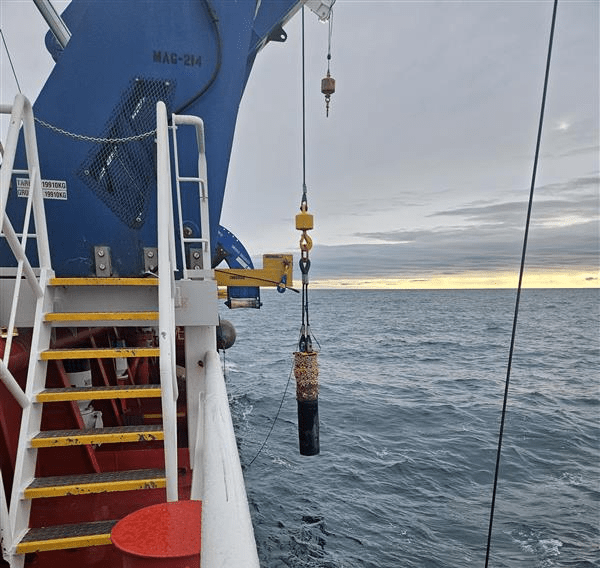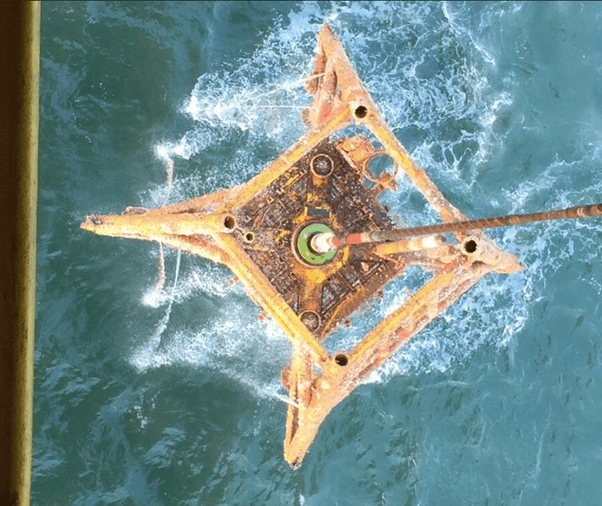
Malory Field

Malory Asset Summary
Malory Unit – Everard 24%, Perenco 76% (Op)
Licences P844 (48/12d) 25%
P461 (48/12c REST & 48/12f REST) 15%
Status – Producing
The Malory Field was discovered in 1997 by Mobil operated well 48/12d-9. It encountered a 76m gas column in good quality Rotliegendes Leman Formation sandstones, with a gas down to at the top of the Carboniferous. A DST flowed at 30.6 mmscf/d and core data confirms permeabilities up to 1651 mD.
The field was developed via an unmanned platform tied back to the Galahad Tee in the Galahad 12in export pipeline which enters the Lancelot Area Production System (LAPS) at the Lancelot Subsea Tee. From this point the Malory production is evacuated to the Perenco Bacton Gas Terminal processing facilities in Norfolk. Production from the 48/12d-9 well commenced in October 1998. The original mapped GIP at Annex B submission was 99 bcf, however by November 2024 the cumulative production was in excess of 169 bcf from the single well.
Perenco UK took over operatorship of the field in 2007 and the current interests in the Malory Field unit are Perenco 76% and Everard Energy 24%. In 2022 the gross production of sales gas from Malory averaged between 5.5 to 6 mmscf/d. Since 2016 decline curve analysis has shown a clear hyperbolic trend with production at Malory anticipated to continue beyond 2030. The cause of the hyperbolic trend and associated pressure support is unproven but is likely to be due to either recharge from an adjacent Rotliegendes fault block or from the Carboniferous formations underlying the Rotliegendes reservoir.
Lancelot Field and
Lancelot Area Production
System (LAPS)

Lancelot Asset Summary
Lancelot Unit – Everard 2% Perenco 98% (Op)
Licences P463 (48/17b) 25%
Status – Producing
The Lancelot Field was discovered in 1986 by the Mobil operated 48/17a-2 well. The field came on stream in July 1993 and gas and condensate from the 1 vertical and 3 horizontal development wells are evacuated via the Lancelot Area Production System (LAPS) pipeline. The gas and condensate are received at the LAPS owned onshore slug-catcher and compressor at Bacton in Norfolk, from where it is delivered over the fence to the Perenco operated Bacton Gas Terminal.
Perenco UK took over operatorship of the field in 2007 and the current interests in the Lancelot Field unit are Perenco 98% and Everard Energy 2%. Cumulative production from the field as of November 2024 was ca. 205 bcf gas. In September 2019, a leak from the Lancelot subsea isolation valve in the export pipeline led to a prolonged shut-in until a successful intervention was achieved in February 2022. Following significant flush production since the wells were brought online in March 2022, the current sales gas production from Lancelot field during the first half of 2023 is between 5 to 7 mmscf/d.
Everard Energy also owns 2% of the Lancelot Area Production System (LAPS) which continues to attract significant third-party business. Several new compression services agreements have been entered into since 2017. In October 2017 production from the Perenco operated INDE area fields arriving onshore was diverted into the available ullage in the LAPS compressor. Perenco operated Leman production entered the LAPS facilities in September 2020. This year (2023) Perenco’s new offshore compression facilities platform 49/27BC came online in mid-2023, boosting the volume of combined flows from the Perenco-operated INDE and Leman area fields through to the LAPS compressor. This new infrastructure, part of Perenco’s Southern Hub Area Rationalisation Project (SHARP) for the Leman and Inde fields, provides a significant life extension for the LAPS shore facilities and the Bacton Gas Terminal. Further third-party gas production will arrive at the LAPS compressor after tie-in works for the Saturn Banks Fields (Operator: CalEnergy Resources) are completed during the 2025 summer shutdown of the Bacton Gas Terminal.
Decommissioning
Guinevere Field

Perenco (Operator) 75%, Everard 25%
The decommissioning of the Perenco operated Guinevere Field (Everard Energy 25%) has been completed. The two platform production wells were plugged and abandoned without the use of drilling rig in early 2017. The export pipeline to the Lancelot platform was flushed clean and air-gapped at Lancelot to render the platform hydrocarbon free by December 2017, and the subsequent heavy lift activity to remove and recycle the topsides and jacket were completed in early 2020. These works were completed on time, under budget and without incident. The remaining remedial pipeline and mattress decommissioning works were performed in 2022 and full close out for wells and installations is expected in late 2025.
LAPS E&A Wells

Perenco (Operator) 98% , Everard 2%
In Q1 2025 the LAPS fields operator Perenco carried out a rigless campaign to plug and abandon its suspended subsea E&A wells in the area using the Multi Service Vessel Kingsborg. The one suspended Lancelot subsea E&A well (48/17b-03) was successfully abandoned as part of this operation.
Juliet Field

Ithaca (Operator) 81% , Everard 19%
The Juliet Field is operated by Ithaca Energy and consisted of two subsea wells tied back to the Pickerill A platform. The field ceased production in 2018 and the subsea facilities were flushed clean to Pickerill A and disconnected, completing its hydrocarbon free status. All subsea facilities in the Juliet 500m zone were removed in 2019, and the remaining subsea Juliet facilities in the vicinity of the Pickerill A jacket were removed in summer 2022. The two Juliet subsea production wells will be abandoned by Ithaca in 2024 as part of a multi-well decommissioning campaign using the Well-Safe Protector. The suspended 48/17b-10 Juliet discovery well was previously plugged and abandoned in 2013 as part of a rigless campaign across the SNS.